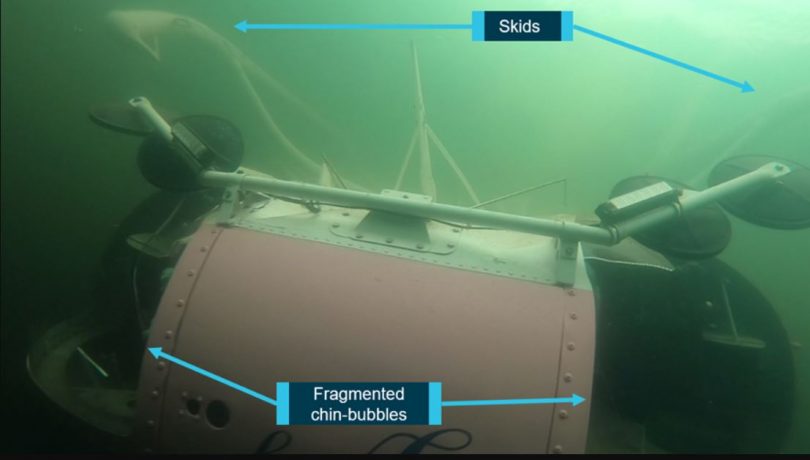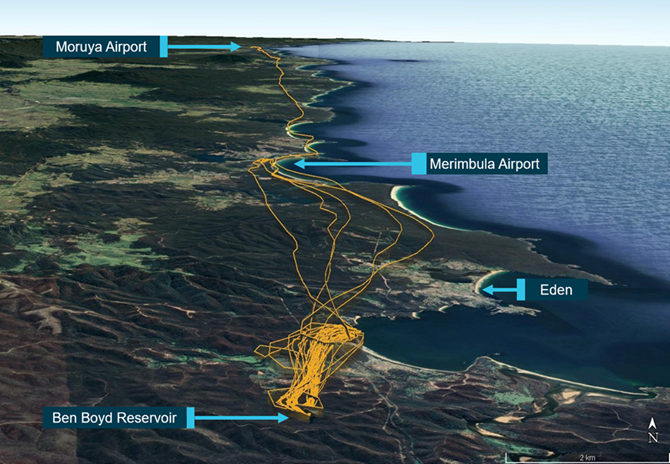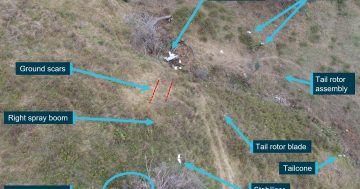
The crashed helicopter being recovered from Ben Boyd Reservoir. Photo: Defence Department.
An aviation safety investigation has heard how a pilot found a pocket of air in his submerged helicopter cabin, giving him the precious breaths of oxygen needed to escape from the crashed aircraft alive.
The accident happened on 9 January 2020 when the firebombing helicopter lost power and dropped into the Ben Boyd Reservoir near Eden.
The UH-1H helicopter was using a 1400 litre water bucket on a 100 foot-long line to collect water from the reservoir to help bushfire clean-up operations in the region.
According to the Australian Transport Safety Bureau (ATSB) report, the helicopter was in a 100-foot hover over the water when the pilot heard a grinding noise. In response, he jettisoned the long-line and bucket and tried to fly towards land.
However, the helicopter experienced a complete loss of engine power and dropped into the water. The impact caused the helicopter’s chin-bubbles to fragment and it rolled upside down, filled with water, and sank.
Unable to open the pilot, co-pilot, or sliding cabin doors, the pilot punched out the right sliding door rear window and escaped the helicopter. He inflated his lifejacket and swam to shore, surviving the accident with minor injuries.
While the pilot was not carrying and was not required to carry, an emergency breathing system (EBS), during the escape he found a pocket of air in the cabin, allowing him to take “a couple of breaths” before swimming to safety.
The ATSB report found the pilot’s difficulty escaping the submerged helicopter highlighted the potential value of carrying emergency breathing systems.
“Research into helicopter overwater accident survival consistently reports drowning as the leading cause of fatalities due to the inability of the occupant to hold their breath long enough to escape,” ATSB Chief Commissioner Angus Mitchell said.

The helicopter upside down in Ben Boyd Reservoir. Photo: Defence Department.
“In this accident, the pilot found an air pocket in the cabin which enabled the escape time to extend beyond the initial breath-hold time. While it could not be determined if the pilot would have drowned without the air pocket, it would have increased that likelihood.
“Although the pilot was able to successfully escape from underwater after finding the air pocket, an emergency breathing system would have reduced the risk of drowning.”
The pilot had conducted a number of helicopter underwater escape training (HUET) courses, a condition of the operator’s contract with the NSW Rural Fire Service. During his interview, the pilot told ATSB investigators he “would have been dead without HUET”.
However, the pilot had not completed the EBS portions of the HUET courses as EBS equipment had not been introduced into his operation.
A range of EBS options are available on the market, including rebreather, compressed air, and hybrid options.
“Helicopter underwater escape training – or HUET – provides a learning environment for the essential skills of maintaining orientation, location, and operation of exits,” Mr Mitchell said.
“However, extended breath-hold may be necessary for problem-solving and physical effort during an underwater escape, such as dealing with snagging hazards, obstructions, or inoperative exits that require an alternative escape route, as in this accident.
“In these scenarios, an EBS can afford the pilot sufficient time to perform the escape actions without an air pocket and therefore reduce the risk of drowning.”
Following the accident, the pilot acquired a compressed air EBS and intends to conduct the EBS elements of future HUET courses.

The flight track and key locations: Photo: ATSB.
“The operator reported they have started investigating how to implement EBS company-wide, and how to attach the units to their pilots without limiting their movement when conducting long-line operations,” Mr Mitchell said.
Following a teardown inspection by the manufacturer, the engine failure was determined to have resulted from inadequate lubrication to two main bearings in the front section of the engine, leading to their failure.
This resulted in contact between the power and compressor shafts, disconnection of rotational drive to the fuel pump and fuel control, and subsequent fuel starvation.
However, the exact cause of the restriction of oil flow to the main bearings in the front section of the engine was not able to be established.







